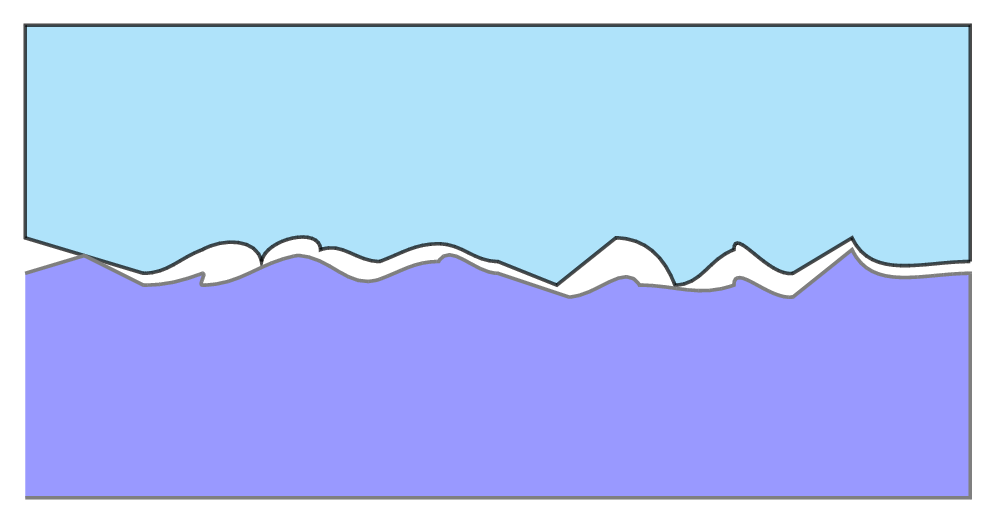Subsection 2.2.1 Contact Forces
Friction: Friction is a resistive force that opposes or tends to oppose relative motion between two objects. It is a force that exists between the surfaces of contact of the two objects. If two systems are in contact and stationary relative to each other, then the friction between them is called static friction. This force arises from mechanical interlocking at the microscopic level plus the electrostatic molecular forces that hold the surfaces themselves together. If two systems are in contact and moving relative to one another, then the friction between them is called kinetic friction. This force arises from forming and breaking of microscopic adhesive bonds between atoms on the surfaces plus some mechanical linkage between the small irregularities on the surfaces. Experimentally it is found that frictional force is proportional to normal force, i.e.,
\begin{equation*}
f \propto N \text{.}
\end{equation*}
or,
\begin{equation}
f = \mu N\tag{2.2.1}
\end{equation}
Where proportionality constant \(\mu\) is called the coefficient of friction. It defines the nature of roughness of the surfaces of contact. Friction decreases with increase in smoothness of the surfaces of contact, but if the surfaces are ultra smooth then friction increases because of inter molecular forces starts to act between the two surfaces as they come very close to each other, due to which it becomes harder to make them slide on each other. Friction is a complex force, and its behavior is still not completely understood. On molecular level friction has no existence.

In microscopic level most surfaces look very rough as shown in figure Figure 2.2.1. Thus, when an object is pushed to move, it must glideover these humppy, bumppy, and ditch types interlock to skip the tips of the surface. A considerable force can be resisted by friction with no apparent motion. Part of the friction is due to adhesive forces between the surface molecules of the two objects, which explains the dependence of friction on the nature of the substances. For example, rubber-soled shoes slip less than those with leather soles. Adhesion varies with substances in contact. Once an object is moving, there are fewer points of contact so less force is required to keep the object moving. At small but nonzero speeds, friction is nearly independent of speed.
In real life frictional forces are almost always present. Remember the direction of frictional force is always opposite to the direction of motion or the applied force. Friction is bad as it dissipates energy but friction is also good as it allows us to roll, turn, walk, and stop. Friction between two solids does not depend on the surface area in contact. Friction can happen, even between surfaces that are not solid such as air drag. Air resistance (drag) during free fall reduces the weight of the object. Air drag (resistance) increases with the velocity of the object in free fall and when it becomes equal to the wight of the object, net force acting on the object is zero and hence the object starts falling with the constant velocity called Terminal Velocity. Skydiving is a good example of terminal velocity.
Normal: This is a force of reaction from the surface where the object is placed. It is always perpendicular to the surface of contact. Tension: is a pulling force. It is a force acting between two objects on opposite ends of the string and acting along the directions to taut string at the point of contact. This force stretches the string along fixed support. Spring force: A spring is a special medium that has ability to restore its shape, if deformed. The elastic property in a material has the ability to restore its shape, if an applied deforming force has been released. From Hook’s law a material (spring) exerts a restoring force that is proportional to a deforming force in opposite direction in which it is stretched or compressed. In mathematical form, spring force,
\begin{equation}
F=-kx\tag{2.2.2}
\end{equation}
where \(k\) is a spring’s stiffness, also called an elastic constant and \(x\) is stretch made on spring.
